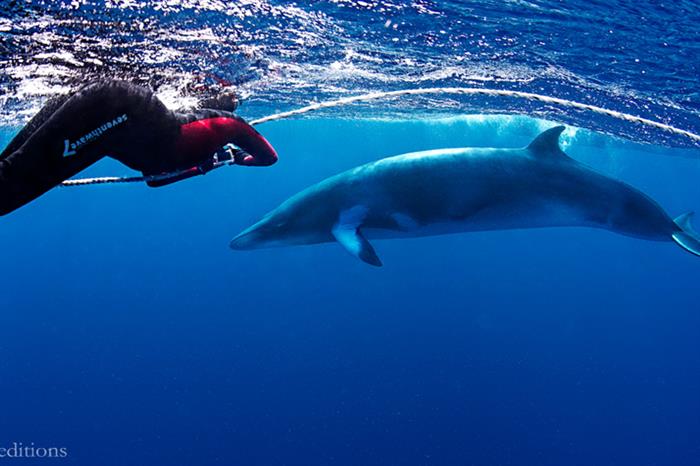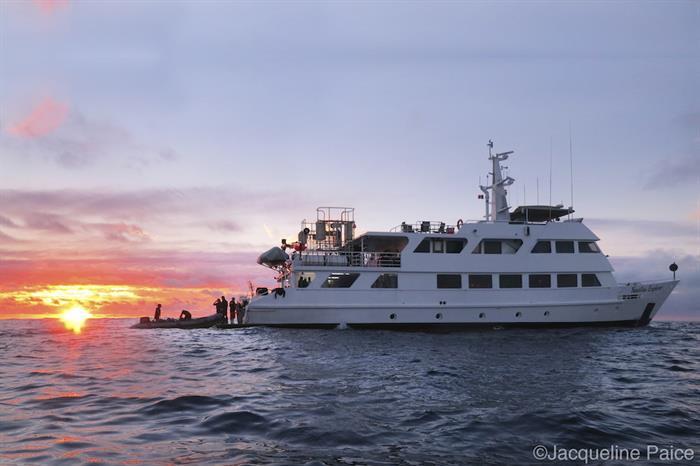Los mejores lugares para bucear en junio

Las ballenas jorobadas están en movimiento durante el mes de junio, lo que permite a los buceadores la rara oportunidad de vislumbrar el mundo de estos gigantes gentiles en lugares como las Islas Galápagos y Australia. Junio es el último mes para dirigirse a Socorro antes de que termine la temporada.
Toparse con una ballena en las Galápagos
Pocas experiencias son más asombrosas que encontrarse cara a cara con una ballena jorobada. Escuchar los sonidos de su canto reverberar a través del océano y de tu caja torácica es suficiente para ponerte la piel de gallina.
Durante junio, las ballenas jorobadas migran a través de las Islas Galápagos, dando a los buceadores la oportunidad de enfrentarse cara a cara con estos mamíferos de 18 metros de largo. Junio también es el momento ideal para los encuentros con tiburones ballena, y estos enormes peces se pueden avistar en abundancia.
Junio marca el inicio de la temporada seca en las Islas Galápagos, cuando prevalecen las temperaturas más frescas y la menor cantidad de lluvias.
Y en la Gran Barrera de Coral
A partir de mayo, los mares tranquilos y la buena visibilidad hacen que el buceo en la Gran Barrera de Coral de Australia sea particularmente alucinante. En junio, el buceo sube otro nivel con la llegada de las ballenas.

Cada invierno, las ballenas minke enanas viajan a través de la Gran Barrera de Coral. La Gran Barrera de Coral es el ÚNICO lugar donde los buceadores y esnórquelistas pueden saltar al agua con estos cetáceos de tamaño reducido. Las ballenas minke enanas crecen hasta un máximo de ocho metros y son criaturas curiosas e inquisitivas. Los cruceros de buceo como Spoilsport ofrecen viajes especiales dedicados a que te sumerjas en el agua con estos animales tantas veces como sea posible.
Nadar con las ballenas minke enanas es apto tanto para buceadores como para esnórquelistas, y esta experiencia es adecuada para todos los niveles de experiencia en buceo. El hecho de que estos tours se realicen en la Gran Barrera de Coral significa que no solo tendrás encuentros inolvidables en el agua con las ballenas, sino que también disfrutarás de algunas inmersiones fantásticas.
Las ballenas jorobadas también se pueden avistar con frecuencia durante esta época del año; sin embargo, por el momento no está permitido nadar con esta especie en la Gran Barrera de Coral. Ver cómo una ballena jorobada salta a metros del barco es impresionante, y estas curiosas ballenas a menudo nadan hacia los cruceros para saludar.
Última oportunidad para el Socorro y el Mar de Cortés
Si amas bucear con los peces grandes (y rayas, ballenas, delfines y más) del mar, Socorro y el Mar de Cortés es un destino que querrás visitar en algún momento de tu vida. La temporada de buceo en Socorro va desde aproximadamente noviembre hasta mayo; sin embargo, algunos cruceros de buceo ofrecen viajes durante la primera mitad de junio, lo que da a los buceadores una última oportunidad para visitar esta increíble parte del mundo antes de que la temporada comience de nuevo. El mejor momento para bucear en el Mar de Cortés es desde principios de agosto hasta octubre; sin embargo, algunos liveaboards, como Nautilus Explorer y Nautilus Belle Amie , ofrecen itinerarios únicos que recorren tanto la Isla Socorro como el Mar de Cortés, permitiendo a los buceadores experimentar lo mejor de ambos destinos.

Socorro es, de hecho, la más grande de las Islas Revillagigedo, que son cuatro islas volcánicas en México. El área solo se puede visitar en cruceros de buceo, ya que es un viaje de unas 24 horas desde el extremo sur de la península de Baja California. Si estás buscando arrecifes de coral y peces coloridos, Socorro no es el lugar para encontrarlos. En cambio, encontrarás encuentro tras encuentro emocionante con una vida marina increíble. Piensa en interacciones con delfines, bancos de tiburones (tiburón tigre, martillo, sedoso y tiburones de Galápagos, por nombrar algunos) y mantarrayas.
Debido a las profundidades, corrientes y condiciones marinas de Socorro, este destino es más adecuado para buceadores de nivel intermedio a avanzado, y la mayoría de los cruceros de buceo requerirán que los buceadores tengan un número mínimo de inmersiones registradas.
Una estrecha franja de agua conocida como el Mar de Cortés está protegida del Océano Pacífico. La posición resguardada de esta extensión de océano da como resultado condiciones de buceo maravillosamente tranquilas y una excelente visibilidad. El Mar de Cortés ofrece a los buceadores la oportunidad de acercarse a juguetones lobos marinos y especies pelágicas, buceo en arrecifes y amplias oportunidades para buscar criaturas macro que no se pueden encontrar en Socorro.











